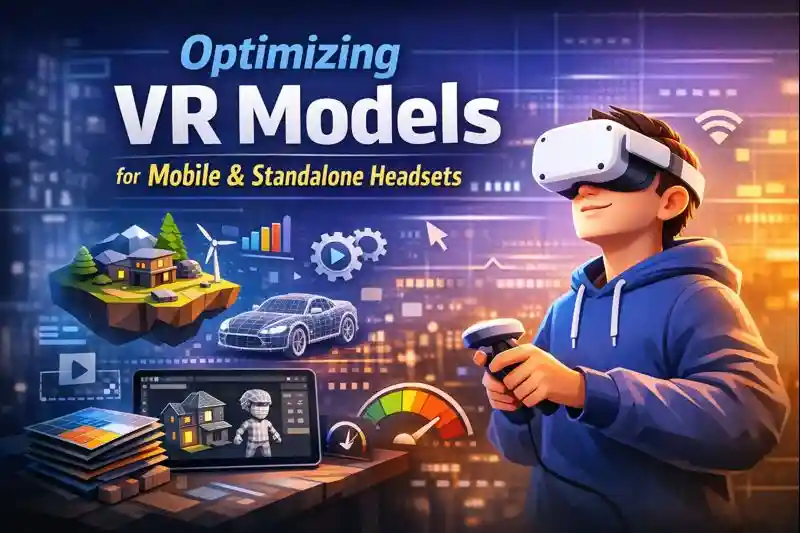Implementing Real-Time Ray Tracing in Game Asset Design
by Animatics Asset Store in Blog on October 27, 2025The gaming industry has embraced new technologies that push the limits of what we thought possible. One such technology is real-time ray tracing. It has completely transformed how light, shadows, reflections, and other visual effects work in video games. But how does this technology impact game asset design, and why has it become so important?
In this article, we’ll dive into real-time ray tracing and how it can be implemented in game asset design. We’ll explore the features of games that have successfully used this technology. We’ll also discuss its pros and cons and look at how asset stores like Animatics Asset Store offer a practical solution for developers seeking the best assets for games.
What is Real-Time Ray Tracing?
Ray tracing is a rendering technique that simulates how light interacts with objects. It traces the paths of light rays as they bounce off surfaces, creating realistic reflections, shadows, and refractions. Real-time ray tracing takes this process and applies it in real-time during gameplay, instead of pre-rendering scenes.
Thanks to advancements in GPU technology, especially with NVIDIA’s RTX series, real-time ray tracing is now possible. This allows developers to use high-quality lighting effects and dynamic visuals without impacting game performance.
Importance in Game Design
In older games, lighting was static, with pre-calculated effects. This worked, but it lacked realism. Ray tracing changes everything. It offers dynamic, lifelike visuals that change as players move through a scene. This adds depth and immersion, making the game world feel alive.
Real-Time Ray Tracing in Action: What Makes Games #1?
Top Games Using This Technique
Games like Cyberpunk 2077, Control, and Battlefield V have successfully implemented real-time ray tracing, and their success shows how powerful this technology can be.
1. Cyberpunk 2077
Cyberpunk 2077 is one of the most visually impressive games ever made, thanks in large part to its use of ray tracing. The game uses ray tracing for reflections, lighting, shadows, and global illumination. For instance, reflections on wet streets and the neon lights of Night City change dynamically as players move through the world. This creates an ever-evolving, vibrant environment.
- Strengths: Stunning lighting, dynamic reflections, and realistic environmental effects.
- Improvements: Ray tracing can cause performance issues on lower-end hardware.
2. Control
Remedy’s Control is another game that pushes the boundaries with ray tracing technique. It uses ray-traced reflections and lighting to create an eerie, atmospheric world. The game’s psychological horror elements are enhanced by light and shadow effects that dynamically change as you move.
- Strengths: Excellent reflections, dynamic lighting, and a deep sense of immersion.
- Improvements: The game’s heavy visual effects can impact performance on lower-end systems.
3. Battlefield V
Battlefield V brought real-time ray tracing to its massive battlefields. The game uses ray tracing to enhance shadows, light reflections, and explosions, creating a more realistic environment. The lighting, particularly in destructible environments, adds to the overall realism.
- Strengths: Immersive battle effects, realistic lighting, and destruction physics.
- Improvements: Ray tracing can lower frame rates, and further optimization is needed.
Features That Make These Games #1
What sets these games apart isn’t just the inclusion of tis technique but how they use it to enhance the overall experience. These games leverage ray tracing to improve atmosphere, environmental storytelling, and player immersion. Here’s how they do it:
- Dynamic lighting effects: Ray tracing simulates how light interacts with objects in real-time, creating lifelike visuals.
- Reflections and refractions: Instead of flat, static reflections, ray tracing provides dynamic, realistic reflections on surfaces like glass, water, and metal.
- Realistic shadows: With ray tracing, shadows are softer, more natural, and change based on light sources.
- Environmental interaction: The dynamic interplay between light and objects creates an interactive world where players feel more connected to their environment.
Areas for Improvement
Despite its impressive visuals, it still has challenges. Performance is one of the biggest issues. Ray tracing requires significant GPU power, which can cause frame drops, especially on lower-end systems. This makes it less accessible for some players.
Another problem is balancing performance and visual quality. While ray tracing enhances graphics, it can also slow down the game, especially when overused. Developers need to find a balance to avoid negatively impacting gameplay performance.
Real-Time Ray Tracing and Game Asset Design
When implementing real-time ray tracing, developers must consider how it affects the assets used in the game. Assets like models, textures, and materials need to be optimized to make full use of ray tracing. For example:
- Materials and shaders: Ray tracing works best with materials like metal, glass, and water. Shaders must be designed to react to light, creating realistic reflections and refractions.
- Lighting and shadow data: Lighting is now dynamic, so designers need to ensure assets are optimized to work with these changes. Assets must include high-quality textures and shaders to maintain visual quality.
- Performance optimization: Since ray tracing demands a lot of processing power, game assets need to be optimized for performance. Developers need lightweight models with optimized textures to keep frame rates high.
Animatics Asset Store: A Solution for Game Asset Design
One challenge when using real-time ray tracing is finding high-quality, optimized assets. This is where stores like Animatics Asset Store can help. While not a promotional piece, the Animatics Asset Store provides a wide range of free and premium 3D models. These models are designed to be compatible with this technique, making it easier for developers to find assets that work well with this technology.
Animatics offers a wide variety of game-ready assets, from characters to environments. These assets come with the necessary textures, lighting, and shaders, ready to be integrated into games with real-time ray tracing.
Why Choose Animatics Asset Store?
- High-quality assets: The assets are designed with ray tracing in mind.
- Free and premium options: Developers can find both free and paid assets, depending on their budget and needs.
- Optimized for ray tracing: The assets are built to integrate seamlessly with real-time ray tracing, saving developers time and effort in creating their own assets.
Conclusion
Real-time ray tracing has significantly changed the landscape of gaming. It has elevated the visual quality of games like Cyberpunk 2077, Control, and Battlefield V, setting new standards for lighting, reflections, and shadows. While ray tracing offers breathtaking visuals, it still presents challenges with performance. Developers need to balance quality and performance to ensure a smooth gaming experience for all players.
For developers seeking high-quality, optimized assets that work well with real-time ray tracing, asset stores like Animatics provide a valuable solution. By using pre-designed assets that are ray tracing-ready, developers can focus more on game mechanics and less on creating assets from scratch.
The future of gaming looks bright, and real-time ray tracing will undoubtedly continue to play a key role in shaping that future. As technology advances, we can expect even more innovative ways to use ray tracing to enhance gameplay experiences.






